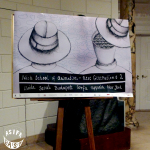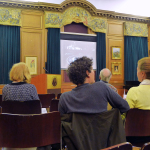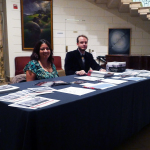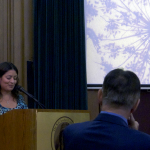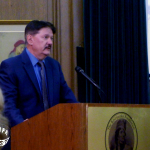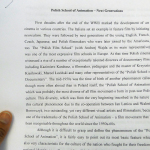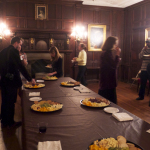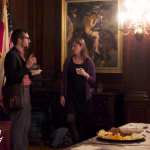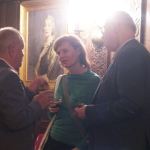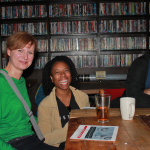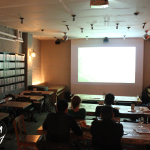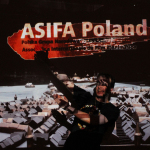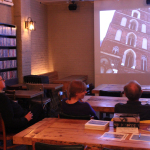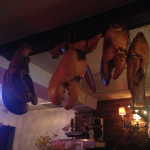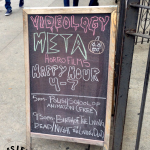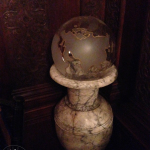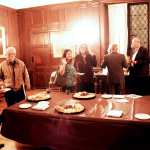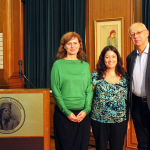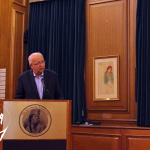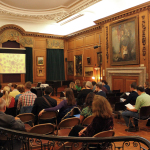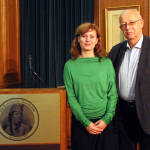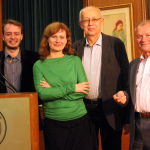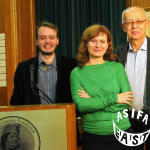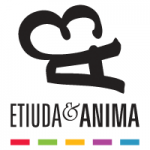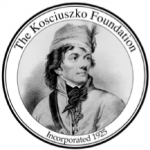“People have problems everywhere,” says Wiola Sowa of ASIFA-Poland, with the light of the projector casting an ethereal glow around her. Sowa was speaking of a recent trip to a film festival in Brazil, where she had found that the content of the films were often as pensive as several of the films we had just seen that night. We all sat engaged in friendly discussion post-screening and pre-drinks on Friday, October 10th, 2014. It was the opening night of a four-day retrospective of The Polish School of Animation. The Kosciuszko Foundation generously hosted the first and fourth nights. Located on East 65th street, just a park-side two-block stroll from the N train, the Kosciuszko Foundation set the stage for a warm, intimate and historical experience. Lavishly decked out in wood and adorned with sculptures, paintings and a marble spiral staircase, the building alone was a sight to behold.
“Who exactly is Kosciuszko?” I whispered to an audience member who had literally just moved to NYC from Poland three months ago. “A military leader, a hero, that guy,” he says pointing to a giant portrait hung against the right wall of the screening room.
The first night we were presented with films from as early as 1958 to as recent as 1981. With World War II’s end in 1945, I was certain a great many films we’d see that night would have some correlation. Sure enough, the WWII theme was quite evident in a few films – such as Ryszard Czekala’s 1958 “Apel” (“The Roll Call”) in which a Nazi soldier plays a sadistic game with his prisoners. Other films, however tackled the overall human dilemma – which may or may not have been inspired by the war. Both Jan Lenica’s 1961 “Labirynt” (Labyrinth) and Daniel Szczechura’s 1968 “Hobby” involved characters that were able to sprout wings and fly away from their problems.
Mechanical workings were also a popular theme, showing up beautifully drawn in Walerian Borowczyk and Jan Lenica’s 1958 “Dom” (House) as well as the aforementioned “Labirynt.” To lighten the evening was Witold Giersz’s 1963 “Czerwone i czarne” (Red and Black). Carefree strokes in simple black and red told the tale of a playful bull and a strategic matador. The film broke the 4th wall – with the characters jumping into and out of inkwells (reminiscent of Max Fleischer’s Koko the Clown) and a camera rotation that revealed the director and camera man who scrambled to get the camera back on target.
Another simply drawn, but comedic film was Stefan Schabenbeck’s 1966 “Wszystko jest liczbą” (“Everything is a Number”) in which our arithmophobic protagonist cannot escape a landscape in which everything is somehow geometric or numeric. A similar crisp line drawing style was employed by Mirosław Kijowicz’s 1971 “Droga” (Road) – a poignant film about a man who splits himself in half to explore two roads simultaneously and in the end cannot piece himself back together again. At the reception, I was told of an old Polish joke (told so many times that no one knows if it’s true) that since the Polish word for road is “Droga” many a Polish tourist get into trouble while asking for directions in Spanish speaking countries.
Delving back into the deeply profound was Jerzy Kucia’s 1979 “Refleksy” (Reflection) the story of two bugs who duke it out only to be crushed by a human anyway. Zbigniew Rybczyński’s 1980 “Tango” is an exceptional depiction of routine displaying more and more characters looping through one room in a sort of dance of daily ritual.
Other films were more abstract in their meaning but visually stunning, such as Jerzy Kalina’s 1981 “Solo na ugorze” (Solo in a Fallow Field) which depicted realistically drawn figures with a trail of their motion behind them, often freezing on one frame of the movement. Wiola Sowa also shared with us her most recent film “Refreny” (Refrains.) Set to whispers of an imaginary language her stream of consciousness film appeared to be beautifully hand-drawn. She revealed to me later that she actually created it all in Photoshop and AfterEffects and used textures she filmed of soot and dust shot on 35mm on glasses to create a multi-plane effect.
The crowd favorite seemed to be Zofia Oraczewska’s 1976 “Bankiet” (The Banquet), which was a clever twist on a delicious dinner party. Well-dressed waiters decorate and set an elaborate table and soon guests pour in, excited to eat the mouth-watering delicacies. Everyone is in for a surprise when the food comes alive and begins to feast on the humans.
Following our dimly lit conversation after the screening, we all poured into a real (and lovely) reception hall with not-alive mouth-watering delicacies (wine and cheese.) I even got to take about a pound of cheese home with me. The cheese didn’t make it through the night, but, don’t worry I shared.
Koniec!
- From the Opening Night at the Kosciusko Foundation!
- Setting Up
- Dayna and Tristian Welcome Guests
- Seats Filling
- Painting OF Kosciusko
- Dayna Presents
- Dr. Micgiel – President of the Kosciuszko Foundation
- Bogusław Zmudziński – artistic director of the International Film
- Speech Translation
- Bogusław Zmudziński
- Wiola Sowa of ASIFA-Poland
- Screen Saver
- Wiola Sowa Discussing Her Film
- Sam Reading Booklet
- Dave Langkamp Asks a Question
- Discussion
- Reception
- Spread
- Dave Chatting
- Reception
- Reception
- Decorations
- Reception
- Tristian Gives Wiola a Gift
- Reception
- Discussion
- Wiola
- Videology Discussion
- Videology
- Tristian
- Tristian with Wiola
- Peaceful Tristian
- Tristian ASIFA Poland
- Pre Screening at Videology
- Screening at Videology
- Poster
- Huh?
- Black Board at Videology
- Wiola Presents
- Wiola Discussion
- Staircase
- Screensaver
- Reception
- Dr Micgiel Presents
- Decoration
- Dayna Waves
- Dayna with Wiola and Bogusław
- Dayna and Caresse
- Bogusław Presents Closeup
- Bogusław Presents
- Wiola and Bogusław
- Tristian with Wiola and Bogusław
- Tristian with Wiola and Bogusław
The screening was part of a 4 night retrospective of Polish animation from the last 60 years, featuring short films and special guests Wiola Sowa (President of ASIFA-Poland) and Bogusław Zmudziński (artistic director of the International Film Festival Etiuda&Anima).
The Kosciuszko Foundation (founded in 1925), promotes closer ties between Poland and the United States through educational, scientific, and cultural exchanges.
The International Film Festival Etiuda&Anima, organized in Kraków since 1994, is the oldest film festival in Poland which juxtaposes the achievements of students of film and art schools from all over the world, as well as works of fine-art animation films creators: professionals, students, as well as independent producers.
Special thanks to our anonymous donor for making our Brooklyn screenings possible.
With the support of the Ministry of Culture and National Heritage of the Republic of Poland and the Polish Film Institute.
Our 2014 New York screenings brought to you by: the International Film Festival Etuida&Anima, The Kosciuszko Foundation, ASIFA-East, and ASIFA-Poland.



